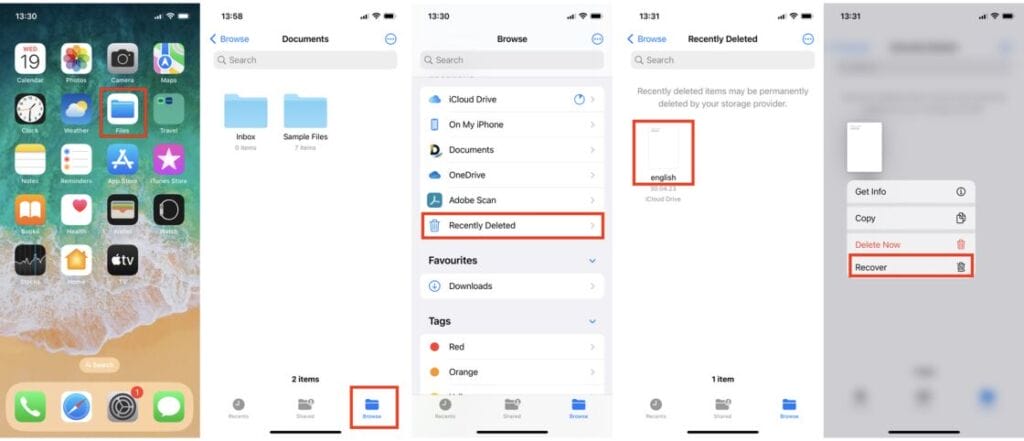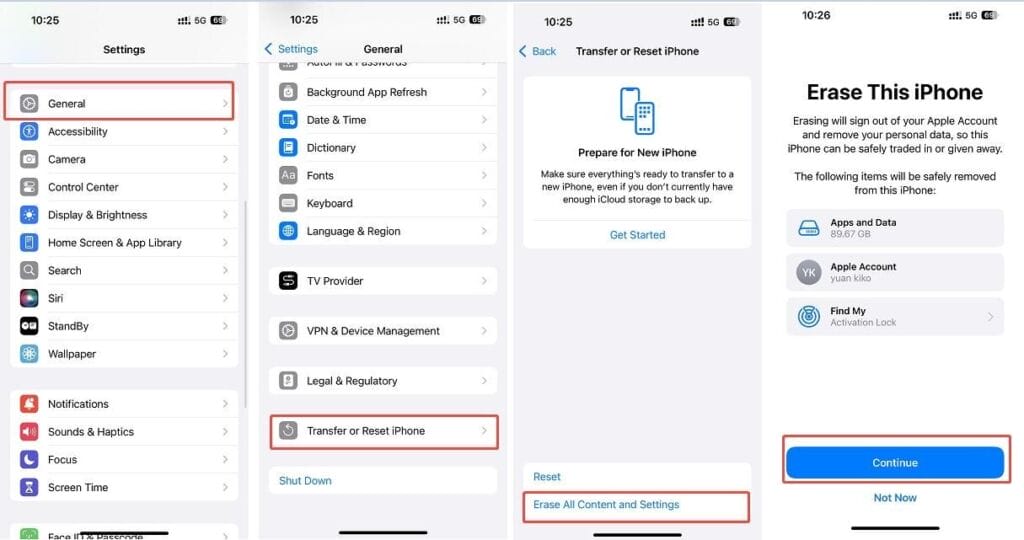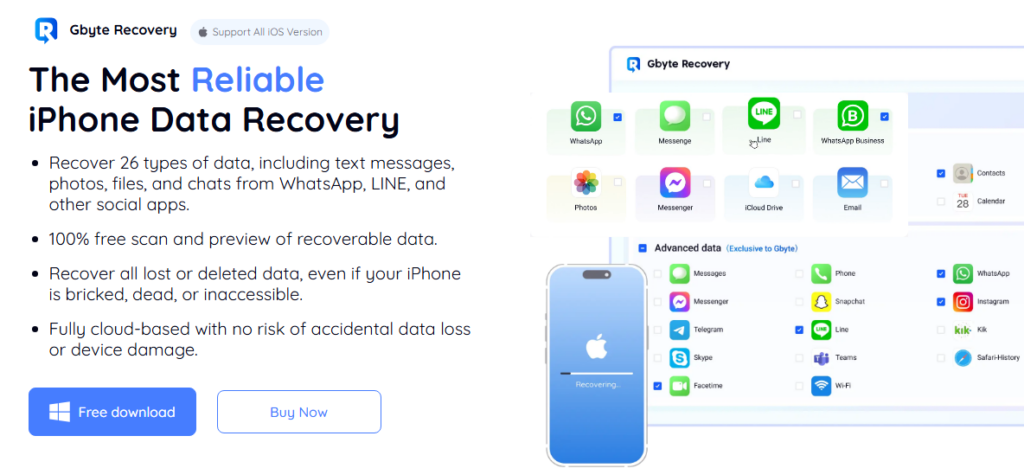The excitement of upgrading to iOS 18 can quickly turn into a nightmare when critical business contracts vanish from your iPhone. This panic is understandable, as these binding agreements form the backbone of your professional life, and such data loss after an update is unfortunately common.
While stressful, the situation is often recoverable. Modern iPhone data recovery techniques have evolved significantly, offering several proven methods to retrieve documents that appear to have vanished into thin air after the update.
Method 1: Check Recently Deleted and Hidden Folders
Start with the most straightforward approach. iOS maintains a Recently Deleted folder that acts as a safety net for accidentally removed files.
Steps:
- Open the Files app on your iPhone
- Navigate to Browse > Recently Deleted
- Look through the contents carefully—contracts might be mixed with other file types
- Select any contracts you find and tap “Recover”

Tips:
Don’t limit yourself to the obvious locations. Check these often-overlooked areas:
- Hidden folders in iCloud Drive
- App-specific storage (if you used apps like Adobe Acrobat or Microsoft Office)
- Downloads folder (contracts might have been moved here during the update)
- Desktop and Documents folders if you sync with a Mac
LOCAL NEWS: Here’s where new Phoenix residents are moving from
INDUSTRY INSIGHTS: Want more news like this? Get our free newsletter here
Method 2: Restore from iCloud or iTunes Backups
If your contracts aren’t in Recently Deleted, the next logical step involves backup restoration. However, this approach comes with significant trade-offs that you should carefully consider.
iCloud Backup Restoration:
- Go to Settings > General > Transfer or Reset iPhone
- Select “Erase All Content and Settings”
- During setup, choose “Restore from iCloud Backup”
- Select a backup dated before your contracts disappeared

iTunes/Finder Backup Restoration:
- Connect your iPhone to the computer where you created backups
- Open iTunes (Windows) or Finder (Mac)
- Select your device and click “Restore Backup”
- Choose the most recent backup that predates the contract loss
Critical Warning: Both methods will completely replace your current iPhone data with the backup version. Any photos, messages, apps, or documents created after the backup date will be permanently lost. This nuclear option should only be considered if your contracts are absolutely irreplaceable and you haven’t created important new data since the backup.
Method 3: Professional Recovery with Specialized Software
When standard recovery methods fall short, professional iPhone data recovery software becomes your most reliable option. These tools can scan deep into your device’s storage structure, locating files that iOS no longer displays through normal interfaces.
The market is flooded with recovery tools that make bold promises but deliver disappointment when you need them most. However, Gbyte Recovery stands out as a particularly effective solution for contract recovery after iOS updates. This isn’t another generic tool that throws random files back at you—it’s built specifically for those critical moments when your important documents have vanished.

Key Advantages of Professional Recovery Software:
Deep Scanning Capabilities: Examines raw storage sectors that standard iOS interfaces can’t access, reconstructing file fragments that appear completely lost.
Selective Recovery: Rather than forcing a complete device restore, you can retrieve only the specific contracts you need without affecting other data.
Non-Destructive Process: Unlike backup restoration methods, this approach doesn’t overwrite existing iPhone data. Everything is recovered to your computer safely.
Preview Functionality: You can verify that contracts are intact and readable before committing to the recovery process—no unpleasant surprises.
Safety and Security: All data processing occurs locally on your computer—nothing gets transmitted to external servers.
File Format Support: Handles 35+ file types, including PDFs, Word documents, Excel spreadsheets, and other common contract formats.
iOS Compatibility: Works with everything from iOS 9 to the latest iOS 18, including beta versions.
Detailed Recovery Process:
Step 1: Download and Installation
Visit the official Gbyte Recovery website and download the software to your computer (available for both Windows and macOS). The installation process is straightforward and doesn’t require any technical expertise.
Step 2: Data Type Selection
Launch the application and select “Files” or “Documents” as your target recovery category. This focuses the scan specifically on document types rather than wasting time on photos or messages you don’t need.

Step 3: Log in to your iCloud
For contracts lost during iOS 18 updates, iCloud backup analysis often yields the best results since documents are frequently synced to the cloud.
Step 4: Deep Scanning Process The software performs a comprehensive scan that typically takes 15-30 minutes, depending on your device’s storage capacity and your data size. During this time, Gbyte analyzes file system structures, searching for document fragments and metadata that can lead to complete file reconstruction.
Step 5: Preview and Verification
Once scanning completes, you can preview what it can recover directly within the software interface. This critical step allows you to verify that documents are exactly what you want to retrieve before proceeding with recovery and before your purchase.
Step 6: Selective Recovery Choose exactly which contracts to restore and click “Recover to PC.” The selected documents are saved to a designated folder on your computer, typically in easily accessible formats like PDF or their original file types.

Real-World Performance Expectations
Based on extensive testing across different iOS scenarios, Gbyte Recovery maintains impressive success rates:
- Recently deleted contracts: 85-95% recovery rate
- Files lost during iOS updates: 70-85% recovery rate
- Documents from corrupted backups: 60-80% recovery rate
- Long-term deleted contracts: 40-70% recovery rate, depending on device usage
The tool’s honest approach means it won’t show you corrupted files or blank thumbnails. What you see in the preview is what you get in the final recovery.
Cost Considerations and Value
Professional recovery software represents an investment, but when weighed against the value of lost contracts and time spent recreating documents, it often pays for itself immediately. Gbyte offers several pricing options:
- Lifetime License: $149.99 (best value for professionals)
- Annual Plan: $99.96 ($8.33/month, billed yearly)
- Monthly Plan: $49.99 (suitable for one-time emergencies)
For business professionals who regularly handle important contracts, the lifetime license provides ongoing peace of mind, especially when testing iOS betas or managing devices with limited storage.
Why Gbyte Recovery Excels for Contract Recovery
Unlike recovery tools that overpromise and underdeliver, Gbyte uses advanced algorithms specifically designed for iPhone data recovery. In real-world testing scenarios, it consistently maintains stable performance under pressure, whether dealing with accidental deletions, failed iOS updates, or system crashes.
The tool’s strength lies in its combination of speed and accuracy. Scanning an iPhone with substantial storage typically takes under 10 minutes, even when searching for contracts deleted weeks prior. What makes this particularly valuable is that Gbyte doesn’t falsely list unrecoverable items—what appears in the preview is genuinely available for restoration.
Method 4: Third-Party Cloud Storage Recovery
Many professionals store contracts across multiple platforms for redundancy. If your primary copies vanished from iOS 18, check these alternative locations:
Google Drive:
- Open the Google Drive app or visit drive.google.com
- Check the Trash folder for recently deleted items
- Look in shared folders that might contain contract copies
Dropbox:
- Navigate to dropbox.com and sign in
- Visit the “Deleted files” section
- Search for your contract filenames or date ranges
OneDrive:
- Access your Microsoft OneDrive account
- Check the Recycle Bin for document copies
- Review version history for files that might have been modified during the iOS update

Method 5: Email and Communication Platform Recovery
Contracts are frequently shared via email or business communication platforms. These sources can serve as backup repositories:
Email Recovery:
- Search your email for contract attachments using keywords like “contract,” “agreement,” or specific client names
- Check both sent and received messages
- Look in spam/junk folders where notifications might have been filtered
Business Platforms:
- Slack: Search for shared documents in relevant channels
- Microsoft Teams: Check Files tabs in team conversations
- Discord: Review pinned messages and file shares in business servers
Prevention Strategies for Future Updates
While recovery options exist, prevention remains your best defense against future data loss. Implement these strategies before your next iOS update:
- Multi-Platform Syncing: Store contracts in at least two different cloud services (iCloud + Google Drive, for example)
- Regular Exports: Monthly exports important contracts to your computer as a local backup
- Version Control: Maintain numbered versions of evolving contracts (Contract_v1, Contract_v2, etc.)
- Pre-Update Backup: Always create a fresh backup immediately before major iOS updates
- Document Apps: Use dedicated contract management apps that maintain their own backup systems
Recovery Success Rates and Realistic Expectations
Understanding realistic recovery rates can help manage expectations and guide your approach:
- Recently Deleted folder: 95% success rate for files deleted within 30 days
- iCloud/iTunes backup restoration: 90% success rate if backups exist and are recent
- Professional recovery software: 70-85% success rate, depending on how long ago the data was lost
- Third-party cloud recovery: 60-80% success rate depending on sync settings
- Forensic recovery services: 40-70% success rate for severely corrupted data
The key factor in successful recovery is acting quickly. The longer you wait, the higher the chance that new data will overwrite the storage sectors where your contracts reside.
Moving Forward with Confidence
Losing important contracts after an iOS update feels catastrophic, but as this guide demonstrates, multiple recovery paths exist. Start with the simple methods—check the Recently Deleted folders and verify your cloud storage accounts. If those don’t yield results, professional recovery software offers a sophisticated yet user-friendly approach to document retrieval.
Remember that data recovery is often a process of elimination. What works for one situation might not work for another, so be prepared to try multiple approaches. The combination of immediate action, the right tools, and systematic investigation gives you the best chance of recovering your valuable contracts and getting back to business as usual.




